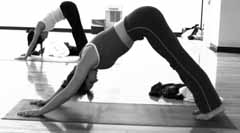Stretching your limits for peace and relaxation
Relax – (r -lks ) v. re·laxed, re·lax·ing, re·lax·es v. tr. – (1) To relieve from tension or strain or (2) To take one’s ease; rest.
School can be very demanding, but two of America’s fastest-growing exercising techniques, yoga and pilates, offer a promising solution for stressed lives.
The word yoga means union. Linguistically, it is related to the old English “yoke.” Traditionally, the goal of yoga is union with the absolute, the true self.
Gaby Lebeau has been teaching yoga for four and one-half years. She explained yoga as a system of poses that help increase strength, balance, flexibility and mental awareness.
“Yoga was developed to get body situated and prepared for meditation and to energize and benefit the body’s focus on refining the mind,” Lebeau said.
According to yogasite.com most western yoga focuses on the physical postures called “asanas,” breathing exercises called “pranayama” and meditation. The focus of yoga today is often on the more down-to-earth benefits of yoga, including improved physical fitness, mental clarity, greater self-understanding, stress control and general well being.
There are four paths or types of yoga with different bases:
1 — Jnana, the path of knowledge or wisdom
2 — Bhakti, the path of devotion
3 — Karma, the path of action
4 — Raja, the path of self-control
Hatha yoga, which includes postures and breathing and is the form most popular in the West, is actually part of raja yoga, the path of self-control.
These yogas all share a common lineage back to Patanjali’s “Yoga Sutras,” a text outlining the basic philosophy and practices of Classical yoga. It was written sometime between the second century B.C. and the first century A.D.
Angie Griswold, pilates teacher at The Sports Academy said pilates was invented by Joseph pilates. pilates moved from Germany in 1912 to England as a boxer but then became a nurse during World War I. He developed a rehab method that evolved into pilates taught today.
After the war he immigrated to the U.S. and started his studio in NYC, which still exists today.
“Pilates does not work on meditation, it’s more about strengthening,” Griswold said.
She said pilates focuses on strengthening the core system. It is used to improve flexibility and posture.
“Every muscle in your body is so compressed. Pilates works to lengthen and relax them,” she said.
Pilates enhances daily life and its quality and assists in almost all athletic activity, Griswold said.
Pilates works the transperse abdominus, rectus abdominus, internal and external obliques, erectrospinae, glutes and hamstrings by a pulley-like system. Pilates works on teaching you control, breathing, flowing movement, centering, isolation and routine.
“[The response to yoga and pilates and other] mind and body classes is wonderful and they do exceptionally well in the gym. Pilates has had a really good response from the participants,” Griswold said.
The Sports Academy is working on bringing more mind and body classes to their facilities because of the positive response. They are training several new instructors and purchasing allegro reformers, or pulley machines used in pilates.
–kassrobison@cc.usu.edu

Nicole Mccoy performs the “Down Dog,” a move used in Yoga. (Photos by K’Leena Murphy)

